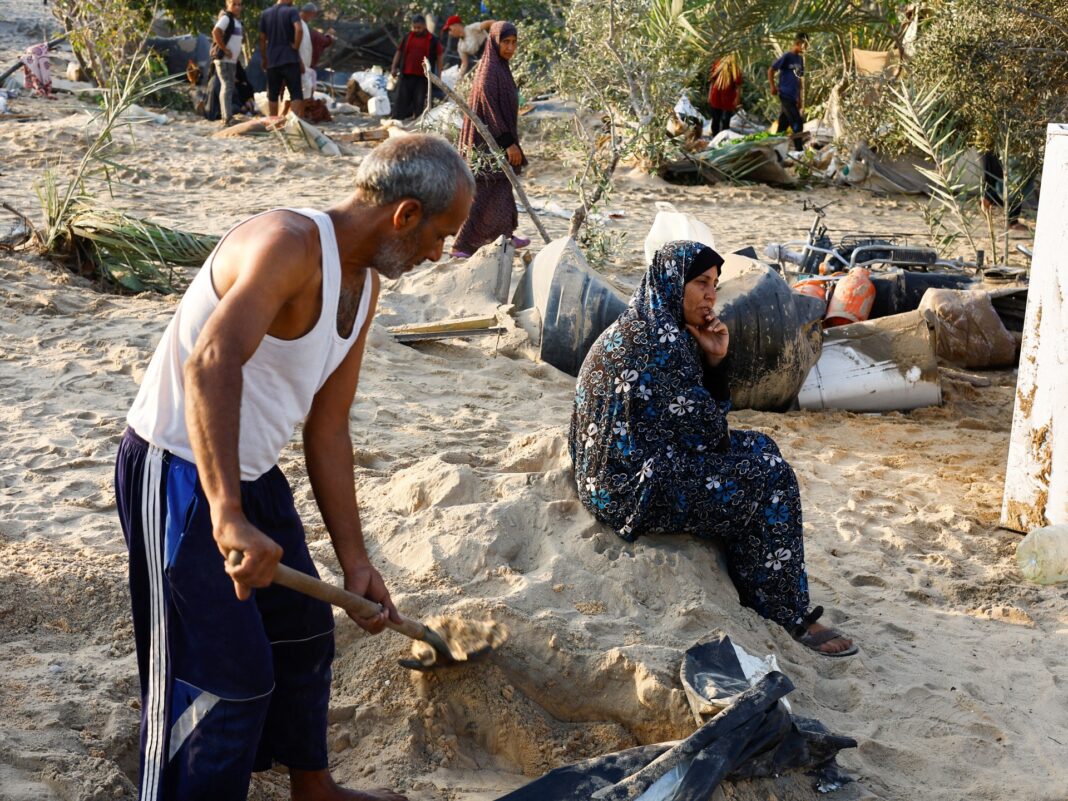The three bombs dropped by Israeli warplanes on displaced people’s tents in southern Gaza left three enormous craters and myriad questions about the use of such big munitions on such a densely populated space.
In the early hours of Tuesday, Israel’s bombing of al-Mawasi killed at least 19 people and wounded many more.
At least 22 people are reported missing, assumed to have been vaporised by the intensity of the blast.
Israel claimed the strikes targeted Hamas militants, while Palestinians and aid groups condemned the attack as a war crime.
What happened?
Initial accounts of the Israeli strike were confused but it soon became clear Israel had struck the encampment with three large projectiles.
Twenty-two-year-old Tala Herzallah described to Al Jazeera she how and her family were asleep about 200 metres (220 yards) away and: “Suddenly, everything was turned upside down.
“The huge damage the bombs caused made us realise that these were meant for the largest buildings and not for tents made of the weakest materials in the world.”
Abu Muhammad al-Bayouk, a displaced person who lives near the encampment, told Al Jazeera: “We heard the explosions. It was … more than a missile. We found many injuries and martyrs and scattered body parts everywhere, including women and children.”
What did Israel use against the tents of al-Mawasi?
Al Jazeera’s verification agency Sanad concluded that US-made MK-84 bombs may have been used by Israel against the encampment of displaced families.
It based this on analysing the size of craters and footage of bomb fragments from the camp.
The MK-84 is 2,000lb ordnance, and one of the heaviest pieces provided to Israel by the US.
The US briefly suspended MK-84 supplies in May, worried that it may use them to assault southern Gaza’s Rafah. Israel proceeded to invade Rafah in May.
Armies tend to use the MK-84 sparingly, but Israel is reported to have used it heavily on Gaza.
The MK-84 causes a pressure wave so intense that, as well as destroying buildings, it exterminates life within a 365-metre (400-yard) radius.
According to the UN, the blast can rupture lungs, tear limbs apart, and burst sinus cavities up to hundreds of metres away from the blast site.
The crater MK-84s leave behind are roughly 15.5 metres wide and 11 metres deep (50 feet wide and 36 feet deep), in keeping with those found at al-Mawasi.
How many people were in the spot Israel hit?
There are no precise counts of people who are in the displacement tents, but Al Jazeera’s Sanad estimates that there were about 60 tents in the space Israel hit.
Previous accounts tell of huge overcrowding, with 20 or more people crammed into one tent to try to shelter from Israel’s ongoing war on the besieged enclave.
By that count it is estimated that at least 120 people were sleeping in the spot where the three large bombs landed.
Why were so many people in al-Mawasi?
Al-Mawasi had been designated as a humanitarian “safe zone” by Israel in October of last year.
Since then, thousands of displaced people have either fled or been instructed by the Israeli army to go there.
There, despite what many describe as appalling conditions, many hoped to find the chance of safety for their families not possible anywhere else in Gaza.
For many, the Israeli army’s assurances, the absence of any highrise buildings nearby, and the fine sand underneath making the chances of Israeli airstrikes upon suspected tunnels unlikely, it was hoped that the camp may at least be secure.
Those hopes were swiftly dashed. Before Tuesday’s attack, al-Mawasi had been struck four times but people stayed on because there was nowhere else to go.
The biggest attack occurred on July 13, 90 people were killed and at least 300 wounded.
At the time, Israel said the attack intended to target two senior Hamas senior commanders, a claim dismissed by Hamas.







